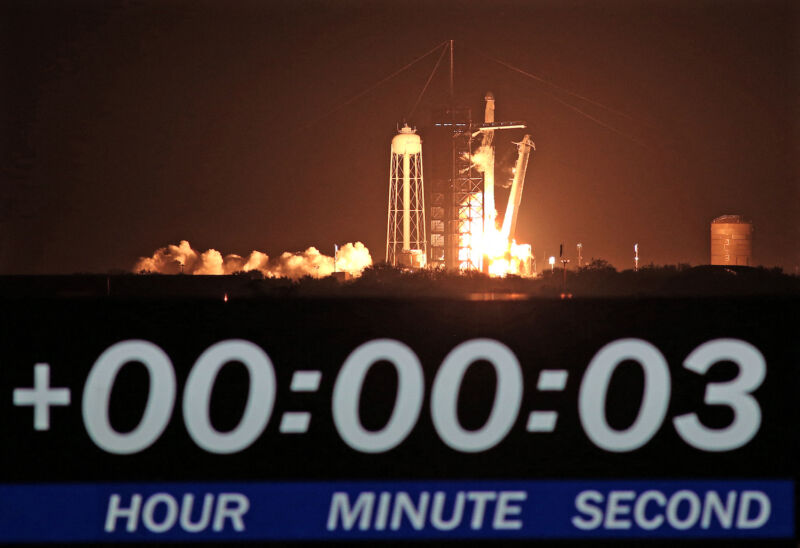
Enlarge / A SpaceX Falcon 9 rocket lifts off with the Crew-8 mission, sending three NASA astronauts and one Russian cosmonaut on a six-month expedition on the International Space Station.
SpaceX’s oldest Crew Dragon spacecraft launched Sunday night on its fifth mission to the International Space Station, and engineers are crunching data to see if the fleet of Dragons can safely fly as many as 15 times.
It has been five years since SpaceX launched the first Crew Dragon spacecraft on an unpiloted test flight to the space station and nearly four years since SpaceX’s first astronaut mission took off in May 2020. Since then, SpaceX has put its clan of Dragons to use ferrying astronauts and cargo to and from low-Earth orbit.
Now, it’s already time to talk about extending the life of the Dragon spaceships. SpaceX and NASA, which shared the cost of developing the Crew Dragon, initially certified each capsule for five flights. Crew Dragon Endeavour, the first in the Dragon fleet to carry astronauts, is now flying for the fifth time.
This ship has spent 466 days in orbit, longer than any spacecraft designed to transport people to and from Earth. It will add roughly 180 days to its flight log with this mission.
Crew Dragon Endeavour lifted off from Florida aboard a Falcon 9 rocket at 10: 53 pm EST Sunday (03: 53 UTC Monday), following a three-day delay due to poor weather conditions across the Atlantic Ocean, where the capsule would ditch into the sea in the event of a rocket failure during the climb into orbit.
Commander Matthew Dominick, pilot Michael Barratt, mission specialist Jeanette Epps, and Russian cosmonaut Alexander Grebenkin put on their SpaceX pressure suits and strapped into their seats inside Crew Dragon Endeavour Sunday evening at NASA’s Kennedy Space Center. SpaceX loaded liquid propellants into the rocket, while ground teams spent the final hour of the countdown evaluating a small crack discovered on Dragon’s side hatch seal. Managers ultimately cleared the spacecraft for launch after considering whether the crack could pose a safety threat during reentry at the end of the mission.
“We are confident that we understand the issue and can still fly the whole mission safely,” a member of SpaceX’s mission control team told the crew inside Dragon.
This mission, known as Crew-8, launched on a brand-new Falcon 9 booster, which returned to landing a few minutes after liftoff at Cape Canaveral Space Force Station. The Falcon 9’s upper stage released the Dragon spacecraft into orbit about 12 minutes after liftoff. The four-person crew will dock at the space station around 3 am EST (0800 UTC) Tuesday.
Crew-8 will replace the four-person Crew-7 team that has been at the space station since last August. Crew-7 will return to Earth in about one week on SpaceX’s Crew Dragon Endurance spacecraft, which is flying in space for the third time.
The Crew-8 mission came home for a reentry and splashdown off the coast of Florida in late August of this year, wrapping up Crew Dragon Endeavour’s fifth trip to space. This is the current life limit for a Crew Dragon spacecraft, but don’t count out Endeavour just yet.
Fleet management
“Right now, we’re certified for five flights on Dragon, and we’re looking at extending that life out,” said Steve Stich, NASA’s commercial crew program manager. “I think the goal would be for SpaceX to say 15 flights of Dragon. We may not get there in every single system.”
One by one, engineers at SpaceX and NASA are looking at Dragon’s structural skeleton, composite shells, rocket engines, valves, and other components to see how much life is left in them. Some parts of the spacecraft slowly fatigue from the stresses of each launch, reentry, and splashdown, along with the extreme temperature swings the capsule sees thousands of times in orbit. Each Draco thruster on the spacecraft is certified for a certain number of firings.
Some components are already approved for 15 flights, Stich said in a recent press conference. “Some, we’re still in the middle of working on,” he said. “Some of those components have to go through some re-qualification to make sure that they can make it out to 15 flights.”
Re-qualifying a component on a spacecraft typically involves putting hardware through extensive testing on the ground. Because SpaceX reuses hardware, engineers can remove a part from a flown Dragon spacecraft and put it through qualification testing. NASA will get the final say in certifying the Dragon spacecraft for additional flights because the agency is SpaceX’s primary customer for crew missions.
The Dragon fleet is flying more often than SpaceX or NASA originally anticipated. The main reason for this is that Boeing, NASA’s other commercial crew contractor, is running about four years behind SpaceX in getting to its first astronaut launch on the Starliner spacecraft.
When NASA selected SpaceX and Boeing for multibillion-dollar commercial crew contracts in 2014, the agency envisioned alternating between Crew Dragon and Starliner flights every six months to rotate four-person crews at the International Space Station. With Boeing’s delays, SpaceX has picked up the slack.